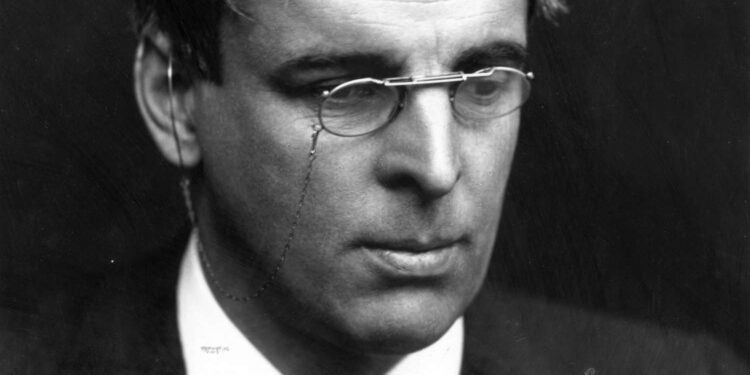Analyze the use of symbolism in William Butler Yeats The Second Coming
William Butler Yeats, one of the most prominent figures of the Irish literary revival, is known for his profound and intricate poetry. Among his notable works, “The Second Coming” stands as a masterpiece that reflects the chaos and uncertainty of the post-World War I era.
Analyze the use of symbolism in The Second Coming:-This essay aims to analyze the effective use of symbolism in the poem, exploring the deeper meanings and implications behind Yeats’ choice of symbols and their relevance to the overarching themes of the poem.
1. Symbolism of the Falcon: One of the most striking symbols in “The Second Coming” is the falcon. The falcon represents power, control, and dominance. In the poem, it is introduced with the line “Turning and turning in the widening gyre,” suggesting a circular motion that signifies the repetitive cycles of history.
Analyze the use of symbolism in The Second Coming:-Yeats uses the image of the falcon to contrast with the image of the falconer, who represents humanity’s attempts to control and maintain order in the world. As the falcon “cannot hear the falconer,” it symbolizes the breakdown of control and the loss of connection between the individual and society.
Also Read:-
- Discuss the theme of disillusionment in F. Scott Fitzgerald’s The Great Gatsby
- Analyze the use of metaphor in Sylvia Plath’s Mirror
- How does Toni Morrison use the concept of race in Beloved
- Analyze the use of symbolism in William Faulkner’s As I Lay Dying
2. Symbolism of the Gyre: The concept of the gyre is central to the symbolism in the poem. A gyre refers to a spiral or circular motion, with one end widening while the other end narrows. Yeats uses the image of the gyre to represent the cycles of history and the inevitability of change. The widening gyre signifies the increasing chaos and disorder in the world, while the narrowing gyre represents the decline of civilizations and the emergence of new ones.
Analyze the use of symbolism in The Second Coming:-This symbol reflects Yeats’ belief that the world was on the brink of a major transformation, where the old order was collapsing, and a new order was about to emerge.
3. Symbolism of the “Blood-dimmed tide”: The phrase “blood-dimmed tide” is a powerful symbol in the poem, evoking images of violence and destruction. It represents the horrors of war and the consequences of human conflict. Yeats wrote “The Second Coming” in the aftermath of World War I, a time when society had witnessed the immense destruction and loss of life. The blood-dimmed tide symbolizes the chaos and suffering brought about by war, as well as the potential for further violence and upheaval in the future.
4. Symbolism of the “Spiritus Mundi”: The “Spiritus Mundi” is a Latin term meaning “spirit of the world” or “collective unconscious.” In the poem, Yeats suggests that the Spiritus Mundi, the collective wisdom and knowledge of humanity, is no longer guiding the world. He writes, “The best lack all conviction, while the worst are full of passionate intensity.”
Analyze the use of symbolism in The Second Coming:-This symbolizes the loss of moral and spiritual values in society, where those who possess wisdom and insight are unable to assert their influence, while those with destructive tendencies are driven by their passionate beliefs.
5. Symbolism of the “rough beast”: The image of the “rough beast” in the poem’s closing lines is a symbol of impending doom and the arrival of a new era. Yeats describes the beast as “slouching towards Bethlehem to be born,” implying that it is slowly approaching, unstoppable, and poised to bring about catastrophic change.
Analyze the use of symbolism in The Second Coming:-This symbolizes the emergence of a destructive force that will challenge and overthrow the existing order. It reflects Yeats’ apprehensions about the future and his belief that the world was on the verge of a radical transformation.
Critical SA of The Second Coming
Analyze the use of symbolism in The Second Coming:-“The Second Coming” is a poem written by W.B. Yeats in 1919, and it is considered one of his most famous works. The poem reflects the sense of disillusionment and despair that prevailed in the aftermath of World War I. It is a highly symbolic and enigmatic piece that has been interpreted in various ways by different readers and critics.
Analyze the use of symbolism in The Second Coming:-The poem consists of four stanzas, each composed of four lines. The structure and rhythm of the poem contribute to its overall impact and create a sense of tension and foreboding. The language used is evocative and vivid, and the imagery is rich and complex.
Analyze the use of symbolism in The Second Coming:-One of the critical aspects of “The Second Coming” is its exploration of the theme of apocalypse or the end of an era. The title itself alludes to the biblical concept of the second coming of Christ, but Yeats uses this idea in a more metaphorical sense.
He portrays a world in turmoil, where traditional values and beliefs are disintegrating, and a new destructive force is about to emerge. The falcon, which is a recurring symbol in the poem, represents this force. It is described as “turning and turning in widening gyre,” indicating a spiral of chaos and destruction.
Analyze the use of symbolism in The Second Coming:-Yeats presents a bleak view of the present age, characterized by moral decay, violence, and political instability. He writes, “Things fall apart; the center cannot hold,” suggesting that the social and political order is collapsing. The poem captures the sense of anxiety and uncertainty that prevailed during the aftermath of World War I, a period marked by disillusionment and a loss of faith in progress.
Analyze the use of symbolism in The Second Coming:-Another critical aspect of the poem is its exploration of cyclical time and the idea that history repeats itself. Yeats writes, “And what rough beast, its hour come round at last, / Slouches towards Bethlehem to be born?” This line implies that the destructive force that is emerging is not new but has appeared before in different forms throughout history. It suggests that humanity is trapped in a cycle of birth, death, and rebirth, with each iteration bringing about its own destruction.
Analyze the use of symbolism in The Second Coming:-The poem’s imagery and language are highly symbolic and open to multiple interpretations. Yeats draws from a variety of mythological, religious, and historical references to convey his ideas. The poem’s complexity and ambiguity allow readers to engage with its themes on different levels and to find personal resonance in its words.
Conclusion
FAQ.
Q: What is the meaning of the phrase “The Second Coming” in Yeats’ poem?
A: In Yeats’ poem, “The Second Coming” refers to the arrival of a new era or a significant historical event. It is a metaphorical expression that suggests a radical transformation or a turning point in history. Yeats believed that the world was on the verge of such a transformation, where the old order was collapsing, and a new order, often associated with chaos and destruction, was about to emerge.
Q: How does the symbolism in “The Second Coming” relate to the historical context of the poem?
A: “The Second Coming” was written in the aftermath of World War I, a period marked by immense destruction and societal upheaval. The symbolism in the poem reflects the anxieties and uncertainties of that time.
The falcon symbolizes the breakdown of control, the gyre represents the cycles of history and the inevitability of change, the blood-dimmed tide signifies the horrors of war, and the rough beast symbolizes the impending arrival of a destructive force. These symbols capture the chaos and turbulence of the post-war era and reflect Yeats’ concerns about the future.
Q: What is the significance of the Spiritus Mundi in the poem?
A: The Spiritus Mundi represents the collective wisdom and knowledge of humanity. In “The Second Coming,” Yeats suggests that this guiding force, which traditionally offers moral and spiritual guidance, is no longer present or influential in the world. This symbolizes the loss of moral values and the absence of a unifying and guiding principle in society. It reflects Yeats’ observation that in his time, those who possessed wisdom and insight lacked conviction, while those driven by passionate but destructive beliefs held influence.
Q: How does the symbolism of the “rough beast” contribute to the poem’s overall meaning?
A: The image of the “rough beast” in the closing lines of the poem represents the imminent arrival of a destructive force or a cataclysmic event. It symbolizes the overthrow of the existing order and the emergence of a new era characterized by chaos and turmoil.
This symbolism reflects Yeats’ apprehensions about the future and his belief that the world was on the brink of a radical transformation. The rough beast embodies the fear and uncertainty associated with profound change and serves as a powerful concluding image in the poem.
Q: Why is “The Second Coming” considered a significant and influential poem?
A: “The Second Coming” is regarded as a significant and influential poem due to its timeless themes, evocative language, and profound symbolism. It captures the anxieties and uncertainties of the post-World War I era and explores universal themes such as the cyclical nature of history, the fragility of civilization, and the potential for radical transformation.
The poem’s vivid imagery and symbolic depth invite multiple interpretations, making it a subject of study and analysis in literature classrooms and a source of inspiration for subsequent generations of poets and writers. Its lasting impact lies in its ability to resonate with readers across different historical and cultural contexts.

















